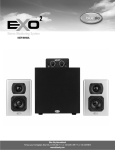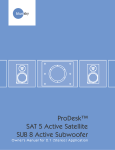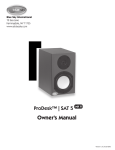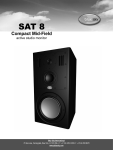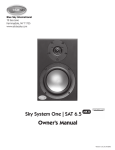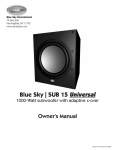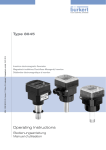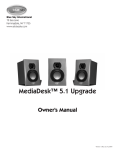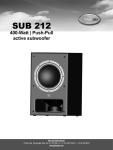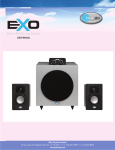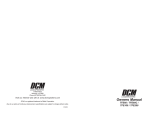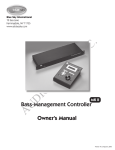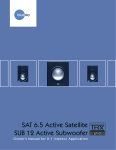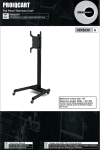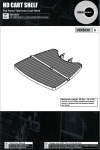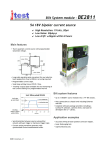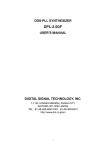Download in wall / on wall
Transcript
I/ON TM in wall / on wall passive studio monitor Blue Sky International 70 Sea Lane, Farmingdale, New York, 11735 USA • T: +1 516 249 1399 • F +1 516 249 8870 www.abluesky.com I/ON TM USER MANUAL • CONTENTS Important 1 2 3 4 5 6 7 8 9 10 11 12 13 14 15 Page 2 • User Manual - Contents Safety Instructions_ _ _ _ _ _ _ _ _ _ _ _ _ _ _ _ _ _ _ _ _ _ Page 3 Welcome to Blue Sky _ _ _ _ _ _ _ _ _ _ _ _ _ _ _ _ _ _ _ _ Page 4 Welcome to I/ON _ __ __ __ __ __ __ __ __ __ __ __ Page 4 An Important Note About I/ON _ __ __ __ __ __ __ Page 4 General I/ON Placement Suggestions_ _ _ _ _ _ _ _ Page 5 In-Wall Mounting Instructions Using Rails _ _ _ _ Page 6 In-Wall Mounting Instructions Using Drywall Anchors _ _ _ __ __ __ __ __ __ __ __ __ __ __ __ __ __ __ __ __ Page 7 On-Wall Mounting Instructions _ __ __ __ __ __ __ Page 8 In-Ceiling Mounting Instructions _ _ _ _ _ _ _ _ _ _ _ _ Page 9 System Signal Connections and Settings_ _ _ _ _ Page 10 Calibration Guide _ __ __ __ __ __ __ __ __ __ __ _Page 11 Technical Information_ _ _ _ _ _ _ _ _ _ _ _ _ _ _ _ _ _ _ Page 12 I/ON Cabinet Dimensions _ __ __ __ __ __ __ __ _Page 13 Factory Service Instructions_ _ _ _ _ _ _ _ _ _ _ _ _ _ _ Page 15 General Contact Details _ _ _ _ _ _ _ _ _ _ _ _ _ _ _ _ _ Page 15 Recycling Information_ _ _ _ _ _ _ _ _ _ _ _ _ _ _ _ _ _ _ Page 15 I/ON TM USER MANUAL • SAFETY INSTRUCTIONS 1 READ INSTRUCTIONS - Read all safety and operating instructions before operating this product. 2. RETAIN INSTRUCTIONS - Retain these safety and operating instructions for future reference. 3. HEED WARNINGS - Follow all warnings on this product and in the operating instructions. 4. FOLLOW INSTRUCTIONS - Follow all operating and use instructions. 9. SERVICING - Do not attempt to service this product yourself. Opening or removing covers, including any over bottom or side speaker drivers, may expose you to dangerous voltage or other hazards. Refer all service to qualified service personnel. 10. DAMAGE REQUIRING SERVICE -Refer servicing to qualified personnel under the following conditions: a. 5. ATTACHMENTS - Do not use attachments not recommended by the product manufacturer as they may cause hazards. 6. WATER AND MOISTURE - Do not use this product near water - for example, near a bathtub, washbowl, kitchen sink, or laundry tub; in a wet basement; or near a swimming pool; and the like. 7. ACCESSORIES - Do not place this product on an unstable cart, stand, tripod, bracket, or table. The product may fall, causing serious injury to a child or adult, and serious damage to the product. Use only with accessories recommended by the manufacturer, or sold with the product. Any mounting of the product should follow the manufacturer’s instructions and should use a mounting accessory recommended by the manufacturer. 8. LIQUID ENTRY - Never spill any liquid of any kind on the product. b. c. d. 11. If liquid has been spilled, or objects have fallen into this product. If the product does not operate normally by following the operating instructions. Adjust only controls that are covered by the operating instructions as an improper adjustment of other controls may result in damage and will often require extensive work by a qualified technician to restore the product to its normal operation. If the product has been dropped or damaged in any way. When the product exhibits a distinct change in performance - this indicates a need for service. REPLACEMENT PARTS - When replacement parts are required be sure the service technician has used replacement parts specified by the manufacturer or have the same characteristics as the original part. Unauthorized substitutions may result in risk of fire, electric shock, or other hazard. User Manual - Safety Instructions • Page 3 I/ON TM USER MANUAL • 1 - 3 • WELCOME & AN IMPORTANT NOTE 1. Welcome to Blue Sky World-renowned for their accurate, full-range sound, Blue Sky studio monitoring systems are used in critical listening applications by audio professionals in a wide variety of industry sectors. Emmy Award-winning sound editor Eric Lalicata, Grammy Award-winning engineer/remixer Roger Sanchez and legendary Talking Heads keyboard/guitarist Jerry Harrison all rely on Blue Sky speakers to check the accuracy of their work before it goes public. And it’s the same story at film sound facility Skywalker Sound and broadcaster ESPN, where Blue Sky speakers once again provide an important link in the production chain. The end result is an on-wall / in-wall passive studio monitor that integrates seamlessly into to your studio, home cinema, boardroom, or other critical listening environment and provides the type of performance our customers have come to expect from Blue Sky. Blue Sky’s fresh approach to studio monitor design delivers the highest possible ratio of performance to cost, in turn providing the highest value to our customers. Making the subwoofer (SUB) an integral part of the monitor system design enables the I/ON studio monitor to be mounted for the best imaging, and the SUB to be positioned for the best bass response. Relieving the I/ON studio monitor of the requirement to reproduce the low frequencies means that the uncompromised sealed-box design, can combine with sophisticated bass management to provide a seamless transition between the I/ON Passive Studio Monitor and SUB. It all adds up to accurate, full range sound. www.abluesky.com 2. Welcome to I/ON Your new I/ON Passive Studio Monitor is more than the typical inwall or on-wall speaker. The I/ON passive studio monitor includes many unique features and benefits, which allow it to far exceed what has come to be expected from passive studio monitors and in-wall or on-wall speakers. Unique features designed into the I/ON monitor include: • Studio grade performance; I/ON is an evolution of Blue Sky’s critically acclaimed SAT 6.5 MK II active studio monitor, and is designed to integrate perfectly with Blue Sky’s SUB 12 and SUB 15 Universal. • Correct 80 Hz roll off; for proper integration with Blue Sky’s, and also many consumer, bass management systems. • Fully sealed box design; for easy installation in a wall, or on a wall, without needing to rely on the inner wall as an enclosure. This provides the correct acoustic volume every time and eliminates the need for an accessory box to seal off the internal wall. • Versatile; the same product mounts either in, or on a wall. It can also easily be mounted vertically, horizontally, or upside down. • Low diffraction cloth grille; greatly minimizes the acoustic impact of the grill cloth and grill frame on the performance of the I/ON passive studio monitor. Items included in the I/ON packaging: 1 I/ON passive studio monitor 2 In wall mounting rails 6 #10-32 X 2” Pan Head Phillips machine screws 4 #10-32 X 1½” Flat head Phillips machine screws 2 Sets of on wall mounting brackets 4 #10 X ¾” Pan Head Phillips sheet metal screws 2 Rubber spacers for on wall mounting 6 #8 Ez-Ancor Medium Plastic wall anchors 6 #8 X 1¾” Pan Head Phillips sheet metal screws 6 #8 Flat washers 4 #8- X 1¼” Pan Head Phillips sheet metal screws 1 Warranty card 2 On-wall mounting templates / horizontal and vertical 1 In-wall mounting template 1 Owner’s manual 3. An Important Note about I/ON Use of a Subwoofer / Bass Management: The I/ON Passive Studio Monitor is designed to be used with a subwoofer and the requisite bass management electronics. Bass-management uses electronic filters to redirect bass frequencies from the main channels to the subwoofer. Bass-management electronics for stereo applications are included in Blue Sky’s SUB 12 and SUB 15 Universal. For surround applications, you must use Blue Sky’s Bass-Management Controller (BMC) MK II, an A/V controller / receiver, or similar product that includes this particular feature set. In order to best match the filters included in Blue Sky’s bass management filters and achieve the best possible summation between the I/ON Passive Studio Monitor and subwoofer, we recommend products that use the following crossover frequency and slopes: High-Pass Filter: 80 Hz / 12 dB per octave Low-Pass Filter: 80 Hz / 24 dB per octave Note: Most THX Certified consumer receivers / controllers include these filters and default to these settings. There are many non THX Certified products that include these filters as well. Consult your owners manual or contact the manufacturer for more specific information. For more information please see page 10 connections and settings]. Page 4 • User Manual • Welcome & An Important Note [System signal I/ON TM USER MANUAL • 4 • GENERAL I/ON PLACEMENT SUGGESTIONS 1) MONITORING HEIGHT RECOMMENDATIONS It is recommended, that when ever possible, mount the I/ON passive studio monitor at or about seated ear height, as shown in Figure 1. Please note, that for surround channel monitor placement, this may not always be desirable, in particular for film / post production applications. See item 3 below for more information. Also see item 4 for additional suggestions regarding placement and I/ON orientation options relative to a HDTV image. Figure 1 Center of the tweeter 2) MONITOR PLACEMENT - OPTIMIZED FOR MUSIC The recommended monitoring angle for proper stereo imaging with music is 60 degrees between the left and right I/ON monitors (see figure 2). In a 5.1 system, the center channel should be located on axis with the reference monitoring position and both the left and right surround channel speakers should be at an angle of 110 degrees from the center line (see figure 3). In most applications, surrounds used for music are placed at the same height as the front speakers for a direct sound field. 3) MONITOR PLACEMENT - OPTIMIZED FOR 5.1 FILM APPLICATIONS Although the above recommendations should work well for both film and music production, there may be situations where a more “film” optimized setup is desirable. To correctly Figure 2 relate audio to picture, the recommended angle between left and right speakers is 45 degrees, as apposed to 60 degrees for music. This narrower monitoring angle typically better matches the width of the picture and should still yield a very satisfactory stereo image. As with the “music” setup, the center channel speaker, should still be located on axis with the reference monitoring position. Unlike music surrounds, which tend to be direct in nature, film surrounds are usually positioned for a more diffused sound field to simulate the effect of an array of surround speakers used in a theater. For a single pair of surrounds, this can be accomplished by placing them two feet above seated ear height, to the side of the monitoring position and slightly behind the mix position. For larger rooms and to cover a larger seating area, it may also be desirable to use multiple surrounds, typically in pairs, as an “array”. 4) LCR PLACEMENT OPTIONS - FILM / POST PRODUCTION APPLICATIONS Figure number 4 shows four sample Left, Center, Right configurations, relative to a typical HDTV image. Depending on the type of installation, one or more of these options may be applicable to your installation. Below are some general guidelines to remember: Center of the woofer Mid-point of the woofer and tweeter B Figure 3 C L R D= B 30° 110° LS RS Reference Monitoring Position SPEAKER PLACEMENT AS DOCUMENTED IN RECOMMENDATION ITU-R BS.775-1 Figure 4 A) The I/ON Passive Studio Monitor can be used in a horizontal or vertical configuration. However, from an acoustic performance stand point, it is typically more ideal to orient the I/ON vertically. This will provide the smoothest horizontal coverage. B) Use the recommendations listed in items 1,2 & 3, to best optimize your LCR channel placement. Additional Technical Resources The Audio Engineering Society • www.aes.org Digital Theater Systems, Inc. • www.dtsonline.com Dolby Laboratories • www.dolby.com Society of Motion Picture and Television Engineers • www.smpte.org THX • www.thx.com User Manual • General I/ON Placement Suggestions • Page 5 I/ON TM USER MANUAL • 5 • IN-WALL MOUNTING INSTRUCTIONS USING RAILS Mounting Rail Level to this line 12.000 11.000 Drill 250" hole or use drywall anchor Drill .250" hole or use drywall anchor Hole for screw to hold mounting rails .250" diameter Not required for mounting with drywall anchors 3.250 Hole for screw to hold mounting rails .250" diameter Not required for mounting with drywall anchors 8.250 9.750 5.000 Drill .250" hole or use drywall anchor Drill .250" hole or use drywall anchor 17.500 15.250 CUTOUT INSIDE THESE LINES Hole for screw to hold mounting rails .250" diameter Not required for mounting with drywall anchors 1/4" Hole Hole for screw to hold mounting rails .250" diameter Not required for mounting with drywall anchors 5.000 8.250 Cutout inside these lines 3.250 Drill .250" hole or use drywall anchor Drill .250" hole or use drywall anchor Figure 5-a Figure 5-b I/ON inwall mounting template 4/27/07 #10-32 -1-3/4" Flat Head Phillips Machine Screw ION template for mounting inwall 4/18/07 #10-32 x 2" Pan Head Phillips Machine Screw Figure 5 I/ON can be mounted in drywall using either the supplied wooden Step 6 Using a drywall saw, cut out the drywall on the inside of the rails or the supplied drywall anchors (mounting instructions for template marked “Cut out inside these lines”. when using drywall anchors is located on page 7). The rails are more appropriate when the drywall is warped. Step 7 Remove the template from the wall Note: I/ON can only be mounted in a wall where there are no electrical wires, pipes, or bracing in the wall. Step 8 Slide the mounting rails in the drywall and secure it to the wall using the four flat head #10 Phillips head machine Mounting I/On in wall using supplied rails: screws. Screw these in the wall so the head is below the Step 1 Using the information on page 5, select the approximate surface. position where you want the speakers located. You will also have to run a pair of speaker wires from the amplifier or Step 9 Locate the speaker wire in the wall. To prevent the wire from receiver to speaker location. The metal push terminals on falling into the wall cavity, you may want to attach the wire to I/ON are compatible with the wires up to #8 AWG. the studs using a plastic wire clamp (not supplied). Step 2 Step 3 Locate the studs. The best method for doing this is by using Step 10 Using the wire strippers, strip approximately 1/2 inch from an electronic stud finder. Follow instructions supplied with each of the wires. Insert the wires in the top or bottom push the stud finder to locate the center and the edges of the stud terminals observing the proper polarity, where the wire going and mark them with a light pencil mark. to the red terminal I/ON goes to the positive terminal on the amplifier which is normally the red terminal. Position the in-wall mounting template between the studs so drywall cutout area clears the studs on both sides. If the Step 11 Carefully slide the I/ON into the opening and secure to cutout interferes with the stud locations you will have to shift the rails using 6- #10-32 X 2” pan head Phillips machine the location of the speaker to clear the studs. screws. Step 4 Once the template is clear of the studs; tape it to the wall using masking tape. Using a level, confirm that template is plumb and level. Readjust if necessary. Step 5 Drill ¼” holes in the 10 locations as indicated on the template. Page 6 • User Manual • In-Wall Mounting Instructions Using Rails I/ON TM USER MANUAL • 6 • IN-WALL MOUNTING INSTRUCTIONS USING DRYWALL ANCHORS Level to this line 12.000 11.000 Drill 250" hole or use drywall anchor Drill .250" hole or use drywall anchor Hole for screw to hold mounting rails .250" diameter Not required for mounting with drywall anchors 3.250 Hole for screw to hold mounting rails .250" diameter Not required for mounting with drywall anchors 8.250 9.750 5.000 Drill .250" hole or use drywall anchor Drill .250" hole or use drywall anchor 17.500 15.250 CUTOUT INSIDE THESE LINES Hole for screw to hold mounting rails .250" diameter Not required for mounting with drywall anchors Wall Anchor Hole for screw to hold mounting rails .250" diameter Not required for mounting with drywall anchors 5.000 8.250 Cutout inside these lines 3.250 Drill .250" hole or use drywall anchor Drill .250" hole or use drywall anchor Figure 6-a I/ON inwall mounting template 4/27/07 ION template for mounting inwall 4/18/07 #8 X 1 3/4" Pan Head Phillips Sheet Metal Screw #8 Flat Washer Figure 6 I/ON can be mounted in drywall using either the supplied wooden rails (mounting instructions for when using the wooden rails is located on page 6) or the supplied drywall anchors. The rails are more appropriate if the drywall is warped. template at the centers of the six anchor locations. Make the indentations deep enough so you can easily find them when you take off the template. Note: I/ON can only be mounted in a wall where there are no electrical Step 6 wires, pipes, or bracing in the wall. Using a drywall saw, cut out the drywall on the inside of the template marked “cut out inside these lines”. Mounting I/ON in the wall using drywall anchors Remove the template from the wall Step 1 Step 7 Using the information on page 5, select the approximate Step 8 position where you want the speakers located. You will also have to run a pair of speaker wires from the amplifier or receiver to speaker location. The metal push terminals on I/ON are compatible with the wires up to #8 AWG. Step 9 Step 2 Using a #2 Philips screwdriver screw the drywall anchors into the drywall using the marks you made in step 5 of this guide. Locate the speaker wire in the wall. To prevent the wire from falling into the wall cavity, you may want to attach the wire to the studs using a plastic wire clamp (not supplied). Locate the studs. The best method for doing this is by using an electronic stud finder. Follow instructions supplied with the stud finder to locate the center and the edges of the stud Step 10 Using the wire strippers, strip approximately 1/2 inch from and mark them with a light pencil mark. each of the wires. Insert the wires in the top or bottom push terminals observing the proper polarity, where the wire going Step 3 Position the in-wall mounting template between the studs to the red terminal I/ON goes to the positive terminal on the so drywall cutout area clears the studs on both sides. If the amplifier which is normally the red terminal. cutout interferes with the stud locations you will have to shift the location of the speaker to clear the studs. Step 11 Carefully slide the I/ON into the opening and secure it to the drywall anchors using six - #8 X 1-3/4” sheet metal screws Step 4 Once the template is clear of the studs, tape it to the wall with #8 flat washers. using masking tape. Using a level, confirm that template is . plumb and level. Readjust if necessary. Step 5 Using a center punch or nail make an indentation in the User Manual • In-Wall Mounting Instructions Using Drywall Anchors • Page 7 I/ON TM USER MANUAL • 7 • ON-WALL MOUNTING INSTRUCTIONS I/O on wall vertical mountign template mounting template vertical 12.000 5.250 2.250 7.500 2.250 Drywall 2.500 2.000 # 8 EZ-Ancor Plastic Wall Anchor Binding Post 7.000 Bracket stop mounted toward bottom of speaker 17.500 #10 X 3/4" Pan Head Phillips Speaker wire Outline of speaker Binding Post Bracket tapered end down Figure 7-b 4/27/07 I/ON on wall Horizontal Mounting template 17.50 Metal Wall Bracket with Stop Mounted Down 12.50 2.50 2.25 2.50 Level to this line 2.00 6.00 Rubber bumper 8.75 #8 x 1-1/4" Pan Head Phillips Sheet Metal screw 12.00 Speaker wire Bracket stop mounted toward bottom of speaker Outline of speaker Figure 7 Figure 7-c 4/27/07 Step 1 Step Step Step Step Step Using the information on page 5, select the approximate position where you want the speakers located. You will also have to run a pair of speaker wires from the amplifier or receiver to this speaker location. The metal push terminals on I/ON are compatible with the wires up to #8 AWG. 2 Locate the studs. The best method for doing this is by using an electronic stud finder. Follow instructions supplied with the stud finder to locate the center and the edges of the stud and mark them with a light pencil mark. 3 Position the on wall mounting template on the wall (either vertical - as shown in Figure 7-b, or horizontal - as shown in figure 7-c) and check the location of the bracket mounting holes in relationship to the studs. If the bracket mounting holes don’t coincide with the studs, then you can use drywall anchors. If one or more the holes end up on a stud you cannot use a dry wall anchor and instead will need to drive the screw directly into the stud. 4 Tape that template to the wall using masking tape. Using a level, confirm that template is plumb and level. Readjust if necessary. 5 Using a center punch or nail make an indentation in the template at the centers of the 4 anchor locations. Make the indentations deep enough so you can easily find them when you take off the template. Where the mounting holes are on a stud, drill 1/8” pilot holes as indicated on the template. 6 Drill an appropriate size hole for the wire approximately 7 inches below and between the brackets. Route your wires from the amplifier through this hole. Once I/ON is mounted on the brackets there is .4” of clearance between the back of I/ON and the wall. If you bring the wire out in the middle Step 7 Step 8 Step 9 Step 10 Step 11 Step 12 Step 13 Step 14 Page 8 • User Manual • On-Wall Mounting Instructions of the wall behind I/ON, you can route the wire behind the speaker to the push terminals on top or bottom concealing the wire. Remove the template from the wall Using a #2 Philips screwdriver screw the drywall anchors into the drywall using the marks you made in step 5 as a guide. Where the holes are located on a stud, do not screw in drywall anchor. Look the supplied metal brackets. You will see that when bracket slides into the other. The outside bracket has to stop on it. Select those brackets and mount them on the wall, using the supplied #8 x 1 ¼” sheet metal screws. Mount them so the stop is towards the bottom of the speaker. Mount the matching brackets to the back of I/ON using #10 X .75” sheet metal screws. The angle side of the bracket mounds towards the bottom of the speaker. Attach the rubber bumpers to the bottom of the speaker. Strip the end of the speaker wire approximately 1/2 inch then attach the plus wire to the red push terminal and the minus wired to the black push terminal. Slide I/On onto the wall brackets. Check to make sure on is plumb in level and adjust the brackets as necessary. I/ON TM USER MANUAL • 8 • IN CEILING MOUNTING GUIDE #10 x 2" Pan Head sheet metal or wood screw 6 plcs into 2 x 4 2 x 10 Ceiling joist added 2 x 4 3" drywall screws minimum 4 thru 2 x 4 into 2 x 10 24" Ceiling joist removed to show detail Center in openning and flush with drywall Figure 6 Note: Note: Step 1 Step 2 Step 3 The only safe way to mount I/ON on the ceiling is to add Step 6 additional 2 X 4 wooden supports between the ceiling joists and to mount I/ON directly to the wooden supports. Do not use drywall anchors or the supplied mounting rails. The procedure described below assumes that the ceiling joists are 2 inches wide and on 16 inch centers. If the spacing of the ceiling joists are greater than 16 inches, the installer will have to build a 2 x 4 box to support I/ON. If the ceiling joists are warped, you may have to cut down the 2 x 4 studs slightly so the studs clear the opening. Step 7 To mount I/ON the ceiling is a two-person job. Cut two 24” long 2 x 4 pieces of lumber, slide through the cutout and drive fit them to the joists. Check that when the two by fours are in place, the 2 X 4s clear the cutout opening. If they do not clear the opening you will have to cut them down so that they do. Once they are clear attach them to the joists and flush with the drywall with a minimum of 4 - 3” long flathead drywall screws. The screws must be counter sunk into the 2 x 4 to clear the body of I/ON when mounted. Run to run a pair of speaker wires from the amplifier or Step 8 receiver to the desired speaker location. The metal push terminals on I/ON are compatible with the wires up to #8 Step 9 AWG. Remove the template from the wall Drill ¼” holes in the 6 locations as indicated on the template. Using the wire strippers, strip approximately 1/2 inch from each of the wires. Insert the wires in the top or bottom push terminals observing the proper polarity, where the wire going to the red terminal I/ON goes to the positive terminal on the amplifier which is normally the red terminal. Locate the ceiling joists. The best method for doing this is by using an electronic stud finder. Follow instructions supplied with the stud finder to locate the center and the edges of the studs and mark them with a light pencil mark. Step 10 Carefully slide I/ON into the opening and secure to the 2 x 4 using 6 - #10 X 2” Pan Head Phillips machine screws. Position the on wall mounting template on the ceiling so the cutout is directly centered between the joists. . Step 4 Tape that template to the wall using masking tape. Step 5 Using a drywall saw, cut out the drywall on the inside of the template marked “Cut out inside these lines”. User Manual • In Ceiling Mounting Guide • Page 9 I/ON TM USER MANUAL • 9 • SYSTEM SIGNAL CONNECTIONS AND SETTINGS TWO CHANNEL CONFIGURATION Figure 11 shows a typical two channel / stereo configuration using a pair of I/ON Passive Studio Monitors in combination with Blue Sky’s SUB 12. The required bass-management electronics for stereo applications are included in Blue Sky’s SUB 12 and SUB 15 Universal. When using I/ON with Blue Sky’s SUB 15 Universal, please set “Crossover Selector Switch” to the “Blue Sky” setting. This will provide the proper bass-management filters for use with the I/ON. 2 CHANNEL AMPLIFIER Figure 11 left channel speaker output left channel ballanced input + – + – right channel ballanced input right channel speaker output + + – – Bass-management uses electronic filters to redirect bass frequencies from the main channels to the subwoofer. Please Note: The I/ON Passive Studio Monitor is not compatible with Blue Sky’s SUB 8 Universal, unless you are using it in combination with Blue Sky’s BMC MK II, or other bass management electronics, which provides the following bass management filters, shown below. FROM SOURCE blue sky international R R IG HT IN R IG HT OUT P US H LE FT IN LE FT OUT P US H S UB IN S UB OUT MUT E P US H P HA S E A UT O 0 OF F 180 S UB G A IN REF -3 100mV =90dB /1m OF F -6 -9 -12 -15 80 Hz 12 dB /OC T 80 Hz 12 dB /OC T -18 -24 80 Hz 24 dB /OC T sub 12 active subwoofer 200 watt LUC A S F I LM R pm3 blue sky international 200 Sea Lane Farmingdale, New York 11735 ON P OWE R 4.0 A MP S L OW B L OW 120 VA C 60 Hz High-Pass Filter: 80 Hz / 12 dB per octave Low-Pass Filter: 80 Hz / 24 dB per octave 430 WAT T S AV IS : R IS QUE DE C HOC E L E C T R IQUE NE PA S OUV IR C A UT ION R IS K OF E L E C T R IC S HOC K DO NOT OP E N ! WARNING: To reduce the risk of fire or electrical shock, do not expose this equipment to rain or moisture. Do not remove cover . No user serviceable parts inside. Refer servicing to qualified personel. designed and tested in the USA made in China SUBWOOFER CONSUMER 5.1 CHANNEL SURROUND CONFIGURATION To to the right is a sample 5.1 channel surround configuration using five I/ON Passive Studio Monitors, a SUB 12, along with a consumer surround receiver for bass-management. For surround applications, you must use either Blue Sky’s Bass-Management Controller (BMC) MK II, an A/V controller / receiver (shown to the right), or similar product that includes bass-management. The chart included in Figure 12, shows the common settings for a typical surround receiver or controller. Please note that the terminology used to describe these settings varies between manufactures. Please consult the manual that came with your receiver or surround controller for more information. R eplac e Only with S ame R ating and Type SAMPLE CONSUMER SURROUND RECEIVER SETTINGS MAIN SETTINGS XOVER FREQUENCY SLOPE LEFT SMALL 80 Hz High Pass 12 dB Per Octave CENTER SMALL 80 Hz High Pass 12 dB Per Octave RIGHT SMALL 80 Hz High Pass 12 dB Per Octave LEFT SRND SMALL 80 Hz High Pass 12 dB Per Octave RIGHT SRND SMALL 80 Hz High Pass 12 dB Per Octave YES 80 Hz Low Pass 24 dB Per Octave SUBWOOFER NOTE: Connection to subwoofer may require RCA to XLR (M) adapter. PLEASE NOTE: The above settings are only shown as an example of a ‘typical’ consumer surround receiver. Many receivers may display these options using different nomenclature. The above settings are the typical default settings for a THX® Certified surround receiver or controller. Please Note: Because Blue Sky’s SUB 15 Universal and SUB 12 include balanced inputs and many consumer receivers and processors included unbalanced outputs, you may need a RCA to XLR (Male) adapter. This will allow you to connect the subwoofer from the receiver’s unbalanced RCA type subwoofer output, to SUB 12 or SUB 15 Universal’s direct inputs, which uses a balanced XLR type connector. For more information see the wiring diagram included in the manual that came with the subwoofer. PROFESSIONAL 5.1 CHANNEL SURROUND CONFIGURATION The I/ON Passive Studio Monitor can also be used as part of a 5.1 professional studio monitoring system. This would require the use of Blue Sky’s BMC MKII, along with a 5-channel amplifier, to power the system. If you would like more information about configuring a 5.1 channel professional monitoring setup, please consult the manual for the BMC MK II, available from the Blue Sky website: www.abluesky.com If you have any questions, please e-mail: [email protected] Page 10 • User Manual • System Signal Connections and Settings Figure 12 I/ON TM USER MANUAL • 10 • CALIBRATION GUIDE Instructions for electroacoustic calibration of a 2.1 audio system using a SPL meter and Blue Sky’s test files. If you are using Blue Sky’s BMC MK II or a consumer receiver / controller for 5.1 etc., use the directions that came with these products for calibration. Before starting this procedure you will need to download BlueSkyTestFiles.zip (an 15 MB zip file) by going to: www.abluesky.com Once downloaded, either burn the test files to a CD or import them into your DAW and follow the instructions below. ADDITIONAL REQUIRED ITEMS 1. 2.1 Monitoring System 2. SPL Meter - such as those sold by RadioShack • • • • BlueSkyTestFiles.zip Includes 4 files: 1000Hz SINEWAVE -20dBFS.wav – a 1kHz file recorded at -20dBFS for electrical calibration 40-80Hz PINK NOISE -20dBFS.wav – a 40Hz to 80Hz bandwidth limited pink-noise file recorded at -20dBFS 500-2.5kHz PINK NOISE -20dBFS.wav – a 500Hz to 2.5Hz bandwidth limited pink-noise file recorded at 20dBFS Pink Noise full bw -20dBFS.wav – a full-bandwidth pinknoise file recorded at - 20dBFS These test files are all mono files. Please make sure you hard assign them to the left and then the right, not both channels at the same time. If you are using a CD player use only one channel of the CD player. Theory The purpose of calibration is to adjust the overall electroacoustics system gain so that 0dBVU of electrical signal level equals a certain acoustic level at the listening position. Since most recording media is now digital, the reference electrical signal level is usually –20dBFS with 20dB of headroom. The reference SPL level however can vary based on the delivery media and speaker type. Please note that the bandwidth limited signals that have been provided, limit many of the room interaction affects often associated with measuring SPL and broadband pink noise. Step 3 Mute everything and make sure the 1kHz tone is OFF . Step 4 Now that the system has been electrically calibrated turn ON the 2.1 Monitoring System (amplifier and subwoofer). Step 5 Assign the 500-2.5kHz pink noise signal to the left channel or right channel only. Make sure there is nothing coming from the right channel (or any other channels). Because this signal is bandwidth limited, you don’t have to worry about turning the subwoofer (SUB) off. There are two methods of setting the levels. A. If you have a master monitor level control, you can set the sat gain control at reference and then adjust the GAIN control on the amplifier for 85 dBc. Then mark that monitor level as your reference position. B. The other method is to set master GAIN control to the position you want as a reference level and then use your own volume controls to set 85 dBc. If you use this method you should mark the knob position with a grease pencil so you can always go back to reference level if the knob gets moved. For either method: SPL should be measured at the mix position, with the SPL meter at arms length, with the microphone at seated ear height, angled at approximately 45 degrees, and pointed at the center point between the left and right speakers. Once the left channel is set to 85dBc, repeat this step for the right channel Step 6 Feed 40-80Hz pink noise signal to the left channel only. Adjust the subwoofer level control (SUB) until the subwoofer measures 85dBc (slow) at the mix position. The meter will bounce around a little, so you will need to do a mental average (I tend to filter out the peaks in my mind, so I don’t set the SUB too hot). The right channel should measure about the same and no additional adjustments need to be made. Step 7 You can play the full-bandwidth pink noise, assigning it to the left and then the right channel (not at the same time). You should measure about 85dBc. It may be a little higher, because below 30Hz the room may have a little extra gain. No adjustments should be made with Full Bandwidth pink noise, unless you have an RTA (real time analyzer). All test signals are recorded at –20dBFS including the 1 kHz sine wave tone. The sine wave tone is used to set the electrical output level throughout the signal path, right up to the point you get to the speakers, while the various pink noise signals are used for acoustic measurements and calibration. The following procedure assumes you are calibrating the system to 85dBc SPL. Step 1 TURN OFF THE MONITORING SYSTEM (until step 4) Step 2 Remove all eq and dynamics from the signal path and set all controls to zero / unity gain. Play the 1kHz Sine Wave, hard assign it to the left channel only, and adjust the output fader so the output meter reads -20dBFS. If you are using an analog console, set the output level to 0 VU. Then hard pan the signal to the right channel output and repeat for the right channel. Once calibrated do not move the output faders. Step 8 You are finished and the calibration process has been completed – enjoy! User Manual • Calibration Guide • Page 11 I/ON TM USER MANUAL • 11 • TECHNICAL INFORMATION & MEASUREMENT DATA SPECIFICATIONS Sealed Enclosure: Solid MDF with 1.5” front & 5/8" rear baffle Weight: 21 pounds- 9.5 kg Dimensions: See page 13 OmniMount Inserts: Four 1/4” x 20 inserts, located on the back of the cabinet, for attachment of OmniMount type 60 brackets (www.omnimountpro.com) or Powerdrive type 100 brackets (www.mypowerdrive.com). Frequency Response: 80 Hz to 20kHz +/- 3 dB Crossover: 2.0 kHz 4th order Sensitivity: 85 dB SPL (2.82V RMS) Impedance: 6 Ohms nominal / 5.5 Ohms minimum Recommended Amplifier Power: 100 to 200 Watts 1” Tweeter Dual concentric diaphragm with integral wave-guide High-power ferrite motor structure Fully video shielded 6.5” Hemispherical Woofer 6.5” high excursion woofer with vented motor Cast aluminum frame 1.5” Aluminum voice coil Copper shorting ring for lower distortion Ultra low power compression design Mica filled polypropylene cone w/ Rubber surround Fully video shielded On axis response versus vertical average, with the grille attached. On axis response versus horizontal average, with the grille attached. On axis response versus listening window, with the grille attached. Page 12 • User Manual • Technical Information & Measurement Data I/ON TM USER MANUAL • 12 • I/ON CABINET DIMENSIONS .500 11.000 4.750 4.250 .500 7.500 2.625 2.000 4.500 8.250 1.000 2.000 2.000 2.000 12.500 8.250 2.000 2.000 5 X 1/4" x 20 inserts 1.250 9.500 2.000 2.000 7.500 1.250 5.750 12.000 3.750 17.500 1.250 15.000 1.250 User Manual • I/ON Cabinet Dimensions • Page 13 I/ON TM USER MANUAL • USER NOTES Page 14 • User Manual • User Notes I/ON TM USER MANUAL • FACTORY SERVICE INSTRUCTIONS, GENERAL CONTACT DETAILS & RECYCLING INFORMATION 13. Factory Service Instructions 14. General Contact Details Service for the U.S. versions of Blue Sky products is available only from our authorized distributor, Group One Ltd., located in Farmingdale, New York. (Service for Blue Sky products outside the United States can be obtained through local dealers or distributors.) If your monitor needs service, follow these instructions: For sales and other enquiries, please contact Blue Sky at: 1. 2. 3. 4. 5. 6. Review the manual and ensure that you have followed all setup and operating instructions. Call (516) 249-1399 9:00am to 5:30pm EST and ask for Customer Service. Explain the problem and request an RA (Return Authorization) number. It is important to have your product serial number available when you call. You must have an RA number before you can obtain service. Pack the product in its original packing material and box. Please do not return the manual or any mounting hardware etc. If you don’t have the original packing material and/ or box, please let Customer Service know when you call for the RA number. Blue Sky is not responsible for any damage that occurs due to non-factory packaging. Include a legible note stating your name, shipping address (no P.O. boxes), daytime phone number, RA number, and a detailed description of the problem, including how it can be duplicated Write the RA number on the top of the carton. Ship the product to the address below. We recommend United Parcel Service (UPS). Please insure the product regardless of shipping method. Blue Sky International ATTN: SERVICE DEPT / RA# 70 Sea Lane Farmingdale, NY 11735 USA 7. Turnaround time is three to five business days depending on the problem. When calling for RA numbers, please ask Customer Service what the turnaround time is. The serviced product will be sent back to you via the same shipping method as received (i.e. if you ship your monitor UPS Ground it will be returned UPS Ground, UPS Red will be returned UPS Red etc...). This only applies to products serviced under the warranty. tel: fax: email: Blue Sky International 70 Sea Lane Farmingdale, NY 11735 USA 516 249 1399 516 249 8870 [email protected] To discover the very latest information check out our website at: www.abluesky.com 15. Recycling Information Blue Sky products are designed to last many years. However, if it turns out that your Blue Sky product is damaged beyond repair, please take care that it is properly recycled in an authorized recycling facility and in accordance with all local environmental legislation. Dismantling of Blue sky products should be done by qualified individuals only. End users should not attempt to dismantle any Blue Sky product! Note the following aspects about recycling some of the main components of our I/ON passive studio monitor: Packing material: Cardboard and plastic can be recycled or burned in a waste disposal oven. Studio Monitor / Speaker Drivers: These items contain several different materials so they should be dismantled for recycling. Crossover Components: These items can be recycled according to your local electronic equipment recycling standards. Do not burn any of the amplifier components. Wiring, Cables and Connectors: These items can be reused in a suitable application or recycled according to your local electronic equipment recycling standards. Cabinets: MDF cabinets can be burned in a controlled high temperature waste disposal oven. User Manual • Factory Service Instructions • General Contact Details • Recycling Information • Page 15 Blue Sky International 70 Sea Lane, Farmingdale, New York, 11735 USA • T: +1 516 249 1399 • F +1 516 249 8870 www.abluesky.com
















